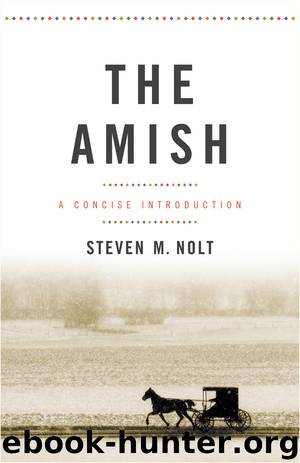The Amish by Steven M. Nolt

Author:Steven M. Nolt
Language: eng
Format: epub
ISBN: 9781421419572
Publisher: Johns Hopkins University Press
Small headstones with simple inscriptions express values of Gelassenheit even in death. Credit: Don Burke
Commitment to the aged is the corollary of Amish concern for maintaining spiritual fidelity with the past. “Perhaps one of the greatest spiritual teachings” he received from his parents and grandparents, reflected one Pennsylvania farmer in 2009, was how those generations “cared for their elderly parents.” His grandparents had “provided living quarters for both [great-grandmothers] in their house and faithfully cared for them till they died … age 93 and 102.” And then “we saw Dad’s care for [our] grandparents” as they “cleaned grandparents’ houses twice a year, cared for their gardens, did some of their sewing, got the estates ready for auction, repaired their broken furniture, and whatever, and read the Bible to them on Sundays.”5 These activities were critical pieces of the writer’s spiritual formation, formation that was centered in the everyday activities of the home. Indeed, the routines and rituals of the home are critically important resources for bringing up children in the Amish way. In recent decades, parents have also had Amish schools to aid them in their efforts.
Who Shall Educate Our Children?
Until the mid-twentieth century virtually all Amish children attended public schools with non-Amish peers, under the instruction of non-Amish teachers. By the beginning of the twenty-first century, however, only a small portion of Amish children were enrolled in public schools (and these were clustered in a handful of settlements). The rise of Amish schools has been one of the most significant developments in the group’s history.
Disaffection with public schools stemmed from three factors, all of which took on new significance as the 1900s wore on. First was the consolidation of rural one-room schools into larger and often town-based facilities. Amish parents preferred small-scale schools, within walking distance, that employed teachers who lived in the local community and knew the parents. Consolidated schools undercut these arrangements. Second, curricula were changing with the addition of science, health, and civics classes that sometimes included—or at least offered the opportunity to include—teaching of evolution, sex education, and patriotism, all of which met with Amish disapproval. Finally, state attendance laws began to override the informal patterns whereby farm kids, and especially boys, could end their schooling with eighth grade and continue their practical education through work experience at home through apprenticeship. As these developments accelerated, an Amish minister asked, “How can we parents expect our children to grow up untainted by the world if we voluntarily send them into a worldly environment, where they associate with worldly companions, and are taught by men and women not of our faith six hours a day, five days a week, for the greater part of the year?”6
Between the mid-1930s and the mid-1960s school authorities and Amish parents skirmished over schooling. Outcomes varied depending on the state or the degree to which either or both sides were willing to negotiate. In some places, fathers paid hefty fines and even sat in jail rather than send their children to high school.
Download
This site does not store any files on its server. We only index and link to content provided by other sites. Please contact the content providers to delete copyright contents if any and email us, we'll remove relevant links or contents immediately.
Under the Banner of Heaven: A Story of Violent Faith by Jon Krakauer(1414)
The Early Centuries - Byzantium 01 by John Julius Norwich(1359)
Taken by J. C. Owens(1278)
In Spirit and Truth (In Spiritu Et Veritate Series) by Reed Zoe(1263)
The Amish by Steven M. Nolt(1253)
Play It as It Lays by Joan Didion(1209)
The Apogee - Byzantium 02 by John Julius Norwich(1161)
The Last Man in Russia by Oliver Bullough(1100)
A History of the Amish by Steven M. Nolt(980)
Tears of the Silenced: A True Crime and an American Tragedy; Severe Child Abuse and Leaving the Amish by Misty Griffin(961)
Leaving the Witness by Amber Scorah(948)
Fallen by unknow(927)
David Sedaris Diaries by David Sedaris(917)
The Angel of Forest Hill by Cindy Woodsmall(898)
The Best of Amish Cooking by Phyllis Pellman Good(882)
The Ariana Trilogy by Rachel Ann Nunes(879)
Escape by Carolyn Jessop & Laura Palmer(875)
Deep Blue by unknow(869)
Primal: A Quest for the Lost Soul of Christianity by Mark Batterson(854)
